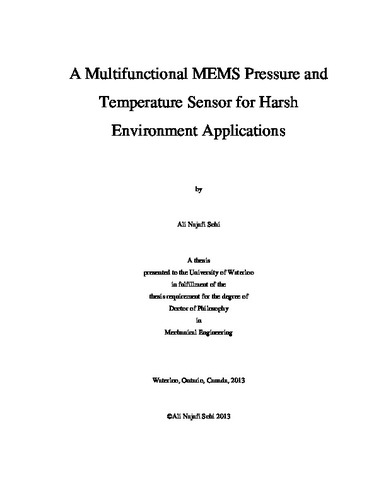| dc.description.abstract | The objective of this thesis was to develop a fast-response multifunctional MEMS (Micro Electro Mechanical Systems) sensor for the simultaneous measurement of in-cylinder pressure and temperature in an internal combustion (IC) engine. In a representative IC engine, the pressure and temperature can reach up to about 1.6 MPa and 580 °C, respectively, at the time of injection during the compression stroke. At the peak of the combustion process, the pressure and temperature near the cylinder wall can go beyond 6 MPa and 1000 °C, respectively. Failure of current membrane-based MEMS pressure sensors operating at high temperatures is mainly caused by cross-sensitivity to temperature, which affects the pressure readout. In addition, the slow thermal response of temperature sensors used for such a dynamic application makes real-time sensing within a combustion engine very challenging. While numerous approaches have been taken to address these issues, no MEMS sensor has yet been reported that can carry out real-time measurements of in-cylinder pressure and temperature.
The operation of the sensor proposed in this Thesis is based on a new non-planar and flexible multifunctional membrane, which responds to both pressure and temperature variations at the same time. The new design draws from standard membrane-based pressure and thermostatic-based temperature MEMS sensing principles to output two capacitance values. A numerical processing scheme uses these values to create a characteristic sensing plot which then serves to decouple the effects of pressure and temperature variations. This sensing scheme eliminates the effect of cross-sensitivity at high temperatures, while providing a short thermal response time. Thermal, mechanical and electrical aspects of the sensor performance were modeled. First, a semi-analytical thermo-mechanical model, based on classic beam theory, was tailored to the shape of the multifunctional membrane to determine the sensor’s response to pressure and temperature loading. ANSYS® software was used to verify this semi-analytical model against finite element simulations. Then the model was then used to calculate the capacitive outputs of the multifunctional MEMS sensor subjected to in-cylinder pressure and temperature loading during a complete cycle of operation of a typical IC engine as well as to optimize the sensor specifications.
Several prototypes of the new sensing mechanism fabricated using the PolyMUMPs® foundry process were tested to verify its thermal behavior up to 125 °C. The experiments were performed using a ceramic heater mounted on a probe station with the device connected to a precision LCR-meter for capacitive readouts. Experimental results show good agreement of the temperature response of the sensor with the ANSYS® finite element simulations. Further simulations of the pressure and temperature response of different configurations of the multifunctional MEMS sensor were carried out. The simulations were performed on an array of 4200 multifunctional devices, each featuring a 0.5 µm thick silicon carbide membrane with an area of 25×25 µm2, connected in parallel shows that the optimized sensor system can provide an average sensitivity to pressure of up to 1.55 fF/KPa (over a pressure range of 0.1-6 MPa) and an average sensitivity to temperature of about 4.62 fF/°C (over a temperature range of 160-1000 °C) with a chip area of approximately 4.5 mm2. Assuming that the accompanying electronics can meaningfully measure a minimum capacitance change of 1 fF, this optimized sensor configuration has the potential to sense a minimum pressure change of less than 1 KPa and a minimum temperature change of less than 0.35 °C over the entire working range of the representative IC engine indicated above.
In summary, the new developed multifunctional MEMS sensor is capable of measuring temperature and pressure simultaneously. The unique design of the membrane of the sensor minimizes the effect of cross-sensitivity to temperature of current MEMS pressure sensors and promises a short thermal response time. When materials such as silicon carbide are used for its fabrication, the new sensor may be used for real-time measurement of in-cylinder pressure and temperature in IC engines. Furthermore, a systematic optimization process is utilized to arrive at an optimum sensor design based on both geometry and properties of the sensor fabrication materials. This optimization process can also be used to accommodate other sensor configurations depending on the pressure and temperature ranges being targeted. | en |

